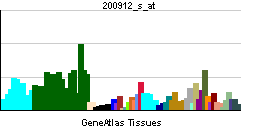EIF4A2
| Eukaryotic translation initiation factor 4A, isoform 2 | |||||||||||
|---|---|---|---|---|---|---|---|---|---|---|---|
| Identifiers | |||||||||||
| Symbols | EIF4A2 ; EIF4A; BM-010; DDX2B; EIF4F | ||||||||||
| External IDs | Template:OMIM5 Template:MGI HomoloGene: 1487 | ||||||||||
| |||||||||||
| RNA expression pattern | |||||||||||
 | |||||||||||
| More reference expression data | |||||||||||
| Orthologs | |||||||||||
| Template:GNF Ortholog box | |||||||||||
| Species | Human | Mouse | |||||||||
| Entrez | n/a | n/a | |||||||||
| Ensembl | n/a | n/a | |||||||||
| UniProt | n/a | n/a | |||||||||
| RefSeq (mRNA) | n/a | n/a | |||||||||
| RefSeq (protein) | n/a | n/a | |||||||||
| Location (UCSC) | n/a | n/a | |||||||||
| PubMed search | n/a | n/a | |||||||||
Eukaryotic translation initiation factor 4A, isoform 2, also known as EIF4A2, is a human gene.[1]
References
Further reading
- Maruyama K, Sugano S (1994). "Oligo-capping: a simple method to replace the cap structure of eukaryotic mRNAs with oligoribonucleotides". Gene. 138 (1–2): 171–4. PMID 8125298.
- Sudo K, Takahashi E, Nakamura Y (1996). "Isolation and mapping of the human EIF4A2 gene homologous to the murine protein synthesis initiation factor 4A-II gene Eif4a2". Cytogenet. Cell Genet. 71 (4): 385–8. PMID 8521730.
- Suzuki Y, Yoshitomo-Nakagawa K, Maruyama K; et al. (1997). "Construction and characterization of a full length-enriched and a 5'-end-enriched cDNA library". Gene. 200 (1–2): 149–56. PMID 9373149.
- Li W, Belsham GJ, Proud CG (2001). "Eukaryotic initiation factors 4A (eIF4A) and 4G (eIF4G) mutually interact in a 1:1 ratio in vivo". J. Biol. Chem. 276 (31): 29111–5. doi:10.1074/jbc.C100284200. PMID 11408474.
- Kyono K, Miyashiro M, Taguchi I (2002). "Human eukaryotic initiation factor 4AII associates with hepatitis C virus NS5B protein in vitro". Biochem. Biophys. Res. Commun. 292 (3): 659–66. doi:10.1006/bbrc.2002.6702. PMID 11922617.
- Strausberg RL, Feingold EA, Grouse LH; et al. (2003). "Generation and initial analysis of more than 15,000 full-length human and mouse cDNA sequences". Proc. Natl. Acad. Sci. U.S.A. 99 (26): 16899–903. doi:10.1073/pnas.242603899. PMID 12477932.
- Gerhard DS, Wagner L, Feingold EA; et al. (2004). "The status, quality, and expansion of the NIH full-length cDNA project: the Mammalian Gene Collection (MGC)". Genome Res. 14 (10B): 2121–7. doi:10.1101/gr.2596504. PMID 15489334.
- Sarkar M, Das S, Bandyopadhaya A; et al. (2005). "Upregulation of human mitochondrial NADH dehydrogenase subunit 5 in intestinal epithelial cells is modulated by Vibrio cholerae pathogenesis". FEBS Lett. 579 (16): 3449–60. doi:10.1016/j.febslet.2005.05.012. PMID 15946665.
- Feng P, Everly DN, Read GS (2005). "mRNA decay during herpes simplex virus (HSV) infections: protein-protein interactions involving the HSV virion host shutoff protein and translation factors eIF4H and eIF4A". J. Virol. 79 (15): 9651–64. doi:10.1128/JVI.79.15.9651-9664.2005. PMID 16014927.
- Cheyssac C, Dina C, Leprêtre F; et al. (2006). "EIF4A2 is a positional candidate gene at the 3q27 locus linked to type 2 diabetes in French families". Diabetes. 55 (4): 1171–6. PMID 16567544.
- Ewing RM, Chu P, Elisma F; et al. (2007). "Large-scale mapping of human protein-protein interactions by mass spectrometry". Mol. Syst. Biol. 3: 89. doi:10.1038/msb4100134. PMID 17353931.
| This protein-related article is a stub. You can help Wikipedia by expanding it. |